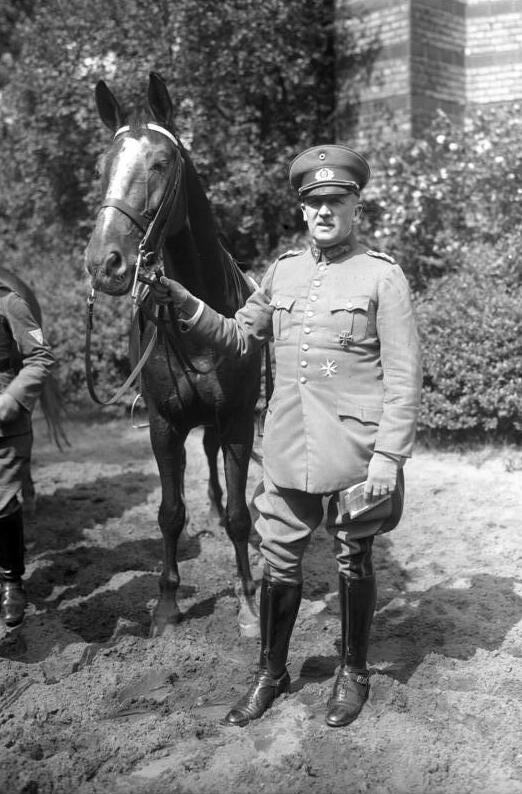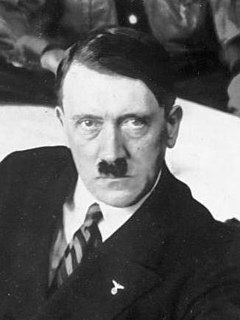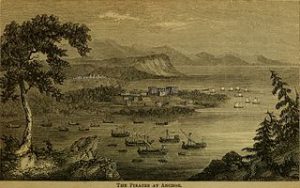Adolf Hitler’s rise to power was a mix of determination and being in the right place at the right time. Much of his luck had to do with the fact that Germany was in a weakened state after World War I. In particular, the Treaty of Versailles was harsh on Germany. They had to pay vast amounts of money to the allied powers and had to weaken their military. This allowed Hitler to swoop in and take advantage of the situation, which culminated in 1932. In that year, there were four nationwide elections. The first one was the presidential election in which Hitler lost to World War I General and President Paul von Hindenburg. At this point in time, Hitler was well known across Germany. Germans were aware that Hitler was indeed a racist and extreme nationalist.1
Hitler desired to be in a position of power to undo the damage and shame that was inflicted on Germany and its people. He fully intended to punish those he thought caused Germany to lose World War I and the ones that were hindering the potential success of Germany. To Hitler, those were Jews, Slavs, and communists. Essentially, anyone in Germany who was not Aryan or at the “top” of the racial hierarchy should be removed from power and influence in German society. Hitler and the Nazi party as a whole determined that the elections of 1932 were the last chance, and that Hitler must attain some sort of position of power, ideally chancellor, so that he could eventually become president and execute the goals of the Nazi party. By July 1932, the Nazi party was the largest party in the Reichstag. It was an astounding rise to power already as they had attained 38% of the votes. This was a meteoric rise in popularity, considering that in the 1928 German elections, they only won about 2% of the votes.2 Hitler, after losing the presidency to Hindenburg in April, demanded he be chancellor. This request was immediately rejected, and Hindenburg instead made Franz von Papen chancellor on June 1, 1932. Just like Hindenburg, he had also served in World War I as an officer and then became a politician afterwards. He was a part of the Catholic Centre Party in the monarchist faction.3 It is important to note that before Papen was made Chancellor, Kurt von Schleicher was the one that suggested him to Hindenburg. Kurt von Schleicher was a military officer just like von Papen and was even a general in the year 1932. He did not truly belong to any one German party but served more as an advisor to Hindenburg.4
There were a multitude of reasons that Hindenburg agreed with Schleicher in appointing von Papen. The first important reason was that he was a conservative and an aristocrat. Hindenburg himself was a conservative aristocrat, meaning that he and von Papen were similar and, therefore, better suited to be chancellor with him. A second was his close ties to the military. Due to the fact that von Papen was once in the military and Schleicher was a general, Schleicher believed that Papen would be easier to control and would work with the military. Schleicher wanted this as it was part of his own plan to attain even more power. The final and possibly the most important reason was that Papen wanted to appease the Nazi party. The Nazi party was the largest political party in Germany and with this popularity, Hitler was able to maintain pressure on Hindenburg to make him chancellor. Schleicher and Hindenburg believed that Papen could negotiate with Hitler and the Nazis in which some Nazi officials can obtain government offices and Hitler could be vice-chancellor to von Papen. Part of this did eventually come true, as on June 14, 1932, von Papen lifted the ban on the SA, the Nazi paramilitary force.5 This meant that the SA were free to once again engage in acts of violence to intimidate political opponents. Papen did believe that Hitler could be contained, as many of the conservatives did. It is also important to note that Schleicher was a member of von Papen’s cabinet as Minister of Defense. With Schleicher being so close to von Papen, he hoped to undermine von Papen’s chancellorship in order to be chancellor himself, replace the German parliamentary system, and subdue the Nazi party.

Schleicher eventually did succeed in undermining von Papen. One major problem that von Papen had was that he had to rely on presidential decrees in order to be chancellor, rather than having support from the government. Article 48 of the Weimar Constitution allows the president to bypass the Reichstag. Von Papen did offer the position of Vice-Chancellor to Hitler, but he declined. Hitler wanted to be Chancellor and Chancellor only. Von Papen had failed to appease the Nazi party and calm them down as the Nazi ideology was increasing in popularity. Papen, on his part, tried to dissolve the Reichstag and hold new elections in November, but it ended up backfiring immediately.6 The result of this was that his government had a tremendous loss of support. The Nazis also lost support but not nearly as much as von Papen.7 The final nail in the coffin for von Papen was the betrayal of Schleicher. This sudden betrayal was ignited by Schleicher’s fears that Papen could attempt an authoritarian coup with the army, which was under Schleicher’s control. In von Papen’s plan, he saw two major problems. The first was that the army was not large or powerful enough to carry out a martial law, due to the treaty of Versailles, especial if the communist paramilitary and Nazi paramilitary, the SA, resisted. The second was that Schleicher knew this wouldn’t go well with the people and feared a civil war, or at the very least, nationwide protests.8 So, with this being said, Schleicher, using Hindenburg’s trust to his advantage, told Hindenburg that von Papen was simply too dangerous to continue to be chancellor and offered himself as the successor, thus undermining von Papen, and later Hitler, which would prove to be fatal for Schleicher.
Hindenburg dismissed von Papen on December 3, 1932, and made Schleicher chancellor the following day. Upon being appointed, Schleicher could now carry out his master plan called Querfront. He believed that in order to stabilize the country and the government, a broad coalition had to be made. This meant uniting certain parts from the political left and political right. He wanted to appeal to moderate trade unions and workers on the left while making the conservative nationalists and the army happy. Unlike von Papen, he wanted to see Hitler and the Nazi’s gone. He did this to isolate the extremist Nazis and the communists, and to lure the more moderate sect of the Nazis away. The overall plan with this was to demonstrate to the people of Germany a united government, without the Nazis and the communists in the picture.9 While attempting the Querfront, Schleicher was attempting something even more ambitious, the complete split of the Nazi party. His target for this plan was a man named Gregor Strasser. At this point in time, Strasser was Hitler’s right hand man. The reason for this was that his ideology was not aligned with Hitler’s at all; in fact, his ideology was more similar to his own. Schleicher then offered to give Strasser positions of power in the government. 10

However, just like von Papen before him, nothing worked. Schleicher had no support from the Reichstag at all. His Querfront was a complete failure as neither the communists nor the labor unions trusted Schleicher. Hindenburg started to lose trust in Schleicher from the very beginning because Schleicher wanted to appease the communists. Then karma eventually came back to bite him as Hindenburg started to listen to von Papen, eager for revenge, who had also teamed up with Hitler. Hitler also figured out what Schleicher and Strasser were up to, which resulted in Strasser getting kicked out of the Nazi party. With all the doors shutting on Schleicher, Hindenburg dismissed him from office on January 28, 1933.11
After this, Papen introduced to Hindenburg a plan to use Hitler for their own personal gain, a plan that ended up being one of the biggest mistakes in human history. In this plan, von Papen suggested to Hindenburg that Hitler should be made Chancellor on the condition that he is Vice-Chancellor and only Wilhelm Frick, one of the founding members of the Nazi party and was the Minister of the Interior, and Hermann Goring, a member of the Nazi party since the beginning and President of the Reichstag, would be a part of his cabinet.12 The rest of the cabinet would be lined with conservative elites, nationalists, and bureaucrats, where Hindenburg and von Papen lie on the political spectrum. The last selling point was that martial law would not be necessary, something that Schleicher advocated for. Overall, this would create the illusion that the government unified the right, with Hitler at the center, when in reality, von Papen and Hindenburg would be in control behind the scenes. Von Papen truly believed that Hitler could be controlled and that eventually through time, the Nazi party will become unpopular and Hitler could then be ousted out of office.13 It’s important to note that Hindenburg detested Hitler, especially seeing how big of a racist he was. He was initially reluctant; however, he did not like the mess that Schleicher created. Finally, two days after dismissing Schleicher, Hitler was appointed chancellor on January 30, 1933.14 At that moment, von Papen truly believed he had the situation in hand and that he held all the political cards. What von Papen did not realize was that Hitler was way more ambitious than he thought and was uninterested in being a pawn in Hindenburg’s and von Papen’s game. Hitler was truly fixated on obtaining absolute power and fixing Germany as he saw fit. The Nazi’s would capitalize on the fact that Goring and Frick were in Hitler’s cabinet. Hitler used Göring and Flick to infiltrate the government to eventually dissolve the Reichstag.15

Von Papen’s plan backfired almost immediately as in the month of March of 1933, he passed the Enabling Act, which made him a dictator. And when Hindenburg died in 1934, no one stood in Hitler’s path. The man that von Papen thought could be used as a pawn was now the king. Freedom of expression was now nonexistent, and his hatred could now be unleashed. In the Night of the Long Knives, he had many of his political opponents and members of his own party killed. Kurt von Schleicher was one of the victims. Hitler had established the Gestapo, secret police that silenced dissent in the population and silenced other political opponents. Quite horrifyingly, he started the HItler Youth, which brainwashed kids into believing that their greatest purpose was to be loyal to Hitler and accept the ideology of the Nazis. This meant believing in the superiority of the Aryan race, the hatred of Jews, Slavs, and other minorities, and that sacrificing one’s life for Germany in war was the greatest honor possible. In 1935, he passed the Nuremberg law’s, which stripped Jews of their citizenship. From here, he then began the killings of six million Jews in the dreaded concentration camps. In terms of foreign policy, he reoccupied the Rhineland, reintroduced conscription for the army, and made an air force, all violations of the Treaty of Versailles. He would then annex Austria in 1938 with no resistance and, in the following year, invaded the rest of Czechoslovakia after he promised not to after obtaining the Sudetenland. The final straw was when he invaded Poland in September of 1939. This ignited World War II, which to this day remains the largest and deadliest conflict known to man.
- Hans Mommsen, The Rise and Fall of Weimar Democracy (Chapel Hill, NC: University of North Carolina Press, 1996), 423. ↵
- Gregori Galofré-Vilà et al.,”Austerity and the Rise of the Nazi Mary,” The Journal of Economic History 81, no. 1 (March 2021): 81. ↵
- William L. Shirer, The Rise & Fall of Adolf Hitler (New York, Random House, 1961), 61. ↵
- Hans Mommsen, The Rise and Fall of Weimar Democracy (Chapel Hill, NC: University of North Carolina Press, 1996), 431. ↵
- Hans Mommsen, The Rise and Fall of Weimar Democracy (Chapel Hill, NC: University of North Carolina Press, 1996), 439. ↵
- William L. Shirer, The Rise & Fall of Adolf Hitler (New York, Random House, 1961), 70. ↵
- Gregori Galofré-Vilà et al., “Austerity and the Rise of the Nazi Mary,” The Journal of Economic History 81, no. 1 (March 2021): 89. ↵
- Hans Mommsen, The Rise and Fall of Weimar Democracy (Chapel Hill, NC: University of North Carolina Press, 1996), 441. ↵
- Hans Mommsen, The Rise and Fall of Weimar Democracy (Chapel Hill, NC: University of North Carolina Press, 1996), 446. ↵
- William L. Shirer, The Rise & Fall of Adolf Hitler (New York, Random House, 1961), 81. ↵
- William L. Shirer, The Rise & Fall of Adolf Hitler (New York, Random House, 1961), 83. ↵
- Daniel Siemens, “The Brown Cult of Youth and Violence in the Weimar Republic,” in Stormtroopers, A New History of Hitler’s Brownshirts (Yale University Press, 2017), 102. ↵
- Hans Mommsen, The Rise and Fall of Weimar Democracy (Chapel Hill, NC: University of North Carolina Press, 1996), 458. ↵
- Volker Ullrich, Hitler: Ascent, 1889-1939, trans. Jefferson Chase (New York: Alfred A. Knopf, 2016), 487. ↵
- Timothy W. Ryback, “How Hitler Dismantled a Democracy in 53 Days,” The Atlantic (blog), January 8, 2025. https://www.theatlantic.com/ideas/archive/2025/01/hitler-germany-constitution-authoritarianism/681233/ ↵




1 comment
Micaella Sanchez
I found it shocking how Adolf Hitler’s rise to power was not just due to his determination, but also the result of underestimation by others like von Papen and Hindenburg. I was amazed by how quickly democracy collapsed once Hitler gained control. This shows the fragility of political systems when power is entrusted to someone with malicious intentions and when others believe they can influence or control them.